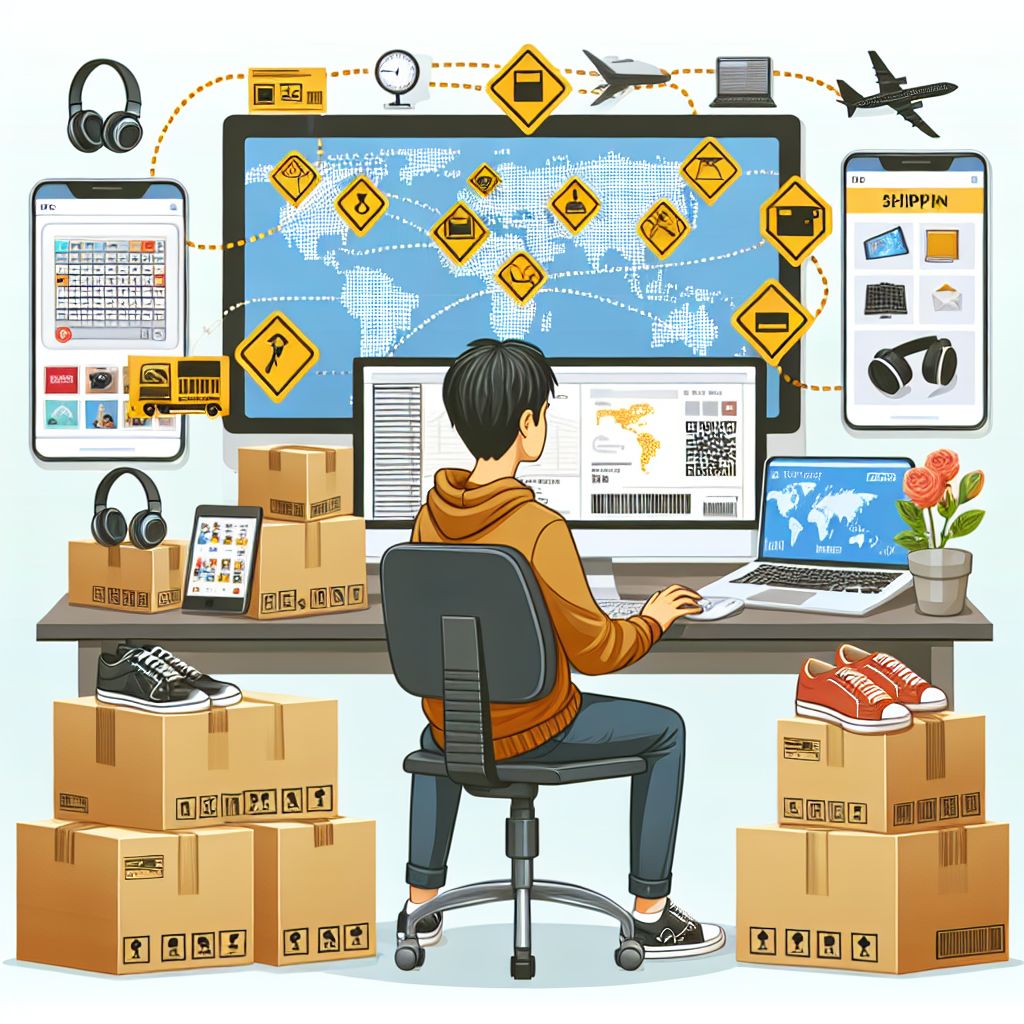
So, you’ve heard about dropshipping, and you’re intrigued by the idea of starting an online business without the need for upfront investment or a garage full of inventory. You’re in the right place. Let’s dive into how you can launch your very own dropshipping business without spending a dime.
Key Takeaways
- Dropshipping is a low-cost entry point into e-commerce.
- You can identify a profitable niche by researching market demand and competition.
- It’s possible to find suppliers and set up an online store without initial costs.
- Marketing strategies like social media can promote your business for free.
- Reinvesting profits and focusing on customer service are key to growth.
Dropshipping Demystified: Start For Free
Defining Dropshipping
Imagine having a store where you sell products but never have to keep them in stock. That’s dropshipping in a nutshell. When a customer buys from you, the order is sent to your supplier, who then ships the product directly to the customer. It’s a hands-off approach that lets you focus on the fun parts of business—like finding cool products and selling them.
Understanding the Economic Edge of Free Dropshipping
Why go for free dropshipping? Because it’s a smart way to test the entrepreneurial waters. You don’t need to shell out for inventory, warehouse space, or worry about unsold stock. This means you can start a business even if your budget is as tight as a new pair of skinny jeans.
Most importantly, the free approach gives you the flexibility to learn and pivot without financial pressure. You’ll have the freedom to experiment with different products and niches until you find your sweet spot.
Finding Your Dropshipping Niche
Identifying a Profitable Niche
Choosing the right niche is like picking the right partner for a three-legged race—you want one that complements you and can go the distance. It should be something you’re passionate about, sure, but it also needs to be profitable.
Analyzing Market Demand
To figure out what will sell, you’ve got to put on your detective hat. Look at trends, search online forums, and consider what problems you can solve. If people are talking about it and looking for it, you might be onto something.
For example, let’s say you notice a lot of chatter about eco-friendly products. That’s a sign there’s a market there. You can then dig deeper into specific products within that niche.
Scoping Out the Competition
Now, don’t get spooked by competition. It’s actually a good sign—it means there’s money to be made. But you do want to stand out, so look for gaps you can fill. Maybe there’s a lack of high-quality options, or perhaps no one’s catering to a particular style or need within the niche. For a more in-depth approach, consider reading this stepwise guide to start free dropshipping for beginners.
Let’s say you’ve decided on eco-friendly office supplies. You notice most stores are selling the same bamboo desk organizers. But what if you found a supplier for sleek, recycled metal versions? That’s your in.
Building Supplier Relationships Without Upfront Costs
Here’s a secret: you can establish relationships with suppliers without spending money upfront. It’s all about communication and mutual benefit. Reach out to potential suppliers with a clear plan of how you’ll drive sales—a compelling pitch can be just as valuable as cash in hand. For more insights, check out getting started with dropshipping.
Be upfront about your free dropshipping model and ask about sample orders, minimum order quantities, and their process. You want to ensure they’re reliable and can handle your customers’ demands. This is a partnership, after all, and your success is tied together.
Launching Your Online Store
Utilizing Free E-commerce Platforms
Think you need a big budget to start an online store? Think again. Platforms like Shopify offer trial periods, while others like WooCommerce are free if you have existing hosting. And don’t forget about marketplaces like eBay or Etsy, where you can set up shop with no upfront costs.
Choose a platform that’s user-friendly and scalable. Remember, you can always upgrade or switch platforms as your business grows. The goal here is to start without financial barriers.
Designing a Customer-Centric Website
Your online store is your digital storefront, and first impressions matter. A clean, easy-to-navigate website will keep customers browsing—and buying. Here’s what you should focus on:
- Clear, high-quality images
- Detailed product descriptions
- Simple, intuitive layout
Don’t get bogged down with fancy features at the start. A clean, simple design that highlights your products is all you need to get going.
For example, if you’re selling fitness gear, use high-energy colors and imagery that evoke a sense of activity and health. Include customer testimonials to build trust and highlight any special offers clearly on the homepage.
As you design, always put yourself in your customer’s shoes. What would make their shopping experience a breeze? That’s what you want to deliver.
Importance of Site Navigation and Product Listings
Site navigation is like the map of your store—it guides customers to what they need. Make sure categories are clear and search functionality is front and center. When it comes to product listings, more information is better. Size guides, multiple images, and FAQs can all help the customer make an informed decision.
Most importantly, ensure your site is mobile-friendly. More and more people shop on their phones, so a mobile-optimized site is essential.
Marketing Your Dropshipping Business
Leveraging Social Media Platforms
Social media isn’t just for sharing memes—it’s a powerful tool to reach potential customers without spending a cent. Choose platforms where your target audience hangs out, and start building a presence there. Post engaging content, interact with users, and showcase your products in action.
For example, if you’re selling kitchen gadgets, share quick recipe videos using your products. Tag them, use relevant hashtags, and encourage followers to share their own experiences.
Creating Content that Converts
Content is king, and in the realm of dropshipping, it’s what can set you apart. Create blog posts, videos, or infographics that provide value to your audience. Teach them something new, solve a problem, or entertain them, and they’ll come back for more—and bring their wallets with them. For more insights, check out the ultimate guide to getting started with dropshipping.
For instance, if you’ve chosen eco-friendly products, write blog posts about living a greener lifestyle or create a video series on recycling hacks. This not only positions you as an authority but also draws in an audience that’s likely to be interested in your products.
Employing Email Marketing Strategies
Email marketing is a powerful, cost-effective way to keep your brand top-of-mind. Use it to nurture leads, announce new products, or offer exclusive deals. And the best part? It’s free to start. Services like Mailchimp offer free plans that are perfect for new dropshippers.
Just remember to provide value in every email. Whether it’s a discount, a useful tip, or exciting news about your niche, make sure your subscribers have a reason to open and click.
Scaling Your Business Without Spending a Dime
Now that you’ve laid the groundwork for your dropshipping empire, it’s time to talk about growth. But how do you scale up without the funds to invest heavily in marketing or inventory? The answer lies in strategic reinvestment and a focus on customer satisfaction.
Reinvesting Profits for Growth
As your dropshipping business starts to make sales, you’ll begin to see some profit. This is where the magic happens. Instead of pocketing all that cash, smart reinvestment can fuel your business’s growth. Here are a few areas where reinvesting your profits can make a big impact:
- Enhancing your website’s design and user experience
- Investing in advanced marketing strategies, like paid ads or SEO services
- Expanding your product range to cater to new or existing markets
Remember, the goal is sustainable growth. Reinvest wisely in areas that will bring the greatest return on investment.
Expanding Your Product Line Responsibly
One of the most exciting parts of running a dropshipping business is the ability to offer new products with just a few clicks. But caution is key. Before adding new products, conduct thorough research to ensure they align with your brand and have a proven demand. Gradually introduce new items and measure their performance. This way, you can scale up without overextending your resources or confusing your customers.
For example, if you started with eco-friendly office supplies, you might consider adding ergonomic furniture as a complementary line once you’ve established a customer base interested in a healthy and sustainable workspace.
FAQs
Got questions? You’re not alone. Here are some common queries from budding dropshippers just like you:
How do I get started with dropshipping if I have no money?
Starting with no money is all about leveraging free tools and platforms. Begin by choosing a niche and selecting products that don’t require upfront purchases. Use free trials or platforms that offer zero-cost entry, and focus on organic marketing strategies like social media and content creation to drive traffic to your store. Learn more about how to find a winning product for dropshipping to ensure your success from the start.
Can I use free platforms for my dropshipping store?
Absolutely! Many platforms offer free entry points for new businesses. Shopify, for instance, has a trial period, and WooCommerce is free with your own hosting. You can also start on marketplaces like Etsy or eBay, which only charge fees when you make a sale.
What is the best way to find a dropshipping supplier?
Finding a good supplier is crucial. Start by searching on platforms like AliExpress or attend trade shows to connect with potential suppliers. Look for those with high ratings, good communication, and positive reviews. Don’t be afraid to ask for references or samples to ensure product quality.
How can I market my dropshipping business with no budget?
There are plenty of free marketing avenues to explore. Social media platforms like Instagram and Facebook offer organic reach. Content marketing through blogs and YouTube can attract customers. Email marketing, when done right, can be a free way to keep your audience engaged and ready to buy.
For example, a dropshipper selling fitness equipment could create workout videos featuring their products and share them on social media and in their email newsletters. This not only showcases the products but also provides valuable content to their audience.
What should I focus on to grow my dropshipping business?
To grow your dropshipping business, focus on understanding your customers’ needs and providing excellent service. Continuously optimize your product offerings based on customer feedback and market trends. Invest in building a strong brand and a community around your products. And always keep an eye on your metrics to understand where to put your efforts.
- Customer service: Respond quickly to inquiries and resolve issues promptly.
- Analytics: Use data to make informed decisions about products and marketing.
- Community: Engage with your customers on social media and build a loyal following.
- Brand: Develop a strong brand identity that resonates with your target audience.
In conclusion, starting a dropshipping business for free is not only possible but also a smart way to enter the world of e-commerce. By choosing the right niche, finding reliable suppliers, and utilizing free platforms and marketing strategies, you can build a successful business without initial investment. Keep your focus on customer satisfaction and strategic growth, and you’ll be well on your way to becoming a dropshipping success story. Remember, the journey of a thousand miles begins with a single step—or in this case, a single click. So go ahead, take that step, and watch your dropshipping dreams take flight.



